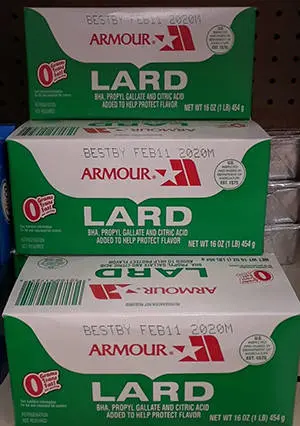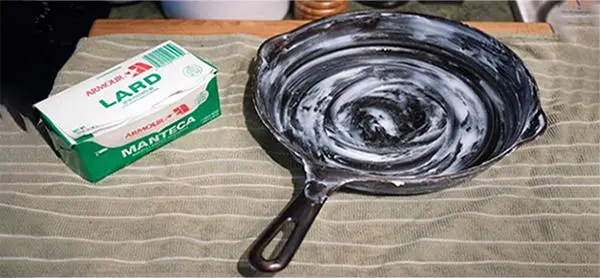My grandmother rendered lard for her family once a year when the hogs were butchered. She used that lard for cooking, baking, frying, household use, and she made the best piecrust you’ve ever tasted with it. For many generations lard was used in the same ways, but then along came cheap cottonseed oil (Crisco) and eventually other vegetable oils. We were told how healthy vegetable oils were, and how “bad” lard was for us. Advertising taught us to think of lard as unhealthy fat clogging up our arteries.
Never mind that my grandfather worked hard on the farm well into his 70’s eating food prepared with lard every day. He never suffered from the diseases caused by our modern diet. Advertising has a lot of influence on the way we think and eat.
Lard is not as unhealthy as we have been led to believe. In fact, it is lower in saturated fat than any other animal fat, including butter. It also has none of the trans-fats that we know are so bad for us. I don’t recommend that you start eating a lot of it, but it is healthier than we’ve been taught – in moderation.
Why We Should Stockpile Lard for SHTF
We need fats in our food storage. Without a little fat to help it along our food will be difficult to cook at times, it won’t taste as good, and we will need the extra calories when times get tough and we have more physical work to do.

Cooking Uses for Lard
#1. Lard is a valued cooking oil because of its desirable flavor and its high smoke point.
#2. Leaf-lard, considered the best for baking, is rendered from the hog’s kidneys and abdomen. It has less pork flavor and produces a grainy or flakey texture in baked goods and confections.
#3. In days gone by lard was spread on bread like butter, or even as a dip.
#4. Historically, lard has served a big role in food preservation. Meat was cooked and stored in lard through the winter until the next slaughter season. (Think duck confit.) It seems foreign to us that meat can be stored without refrigeration, but this method of food storage was frequently used in the past.
Lard for Nutrition
#5. Fat is a nutritional requirement for our bodies and is one of the four main food nutrients that should be in your food pantry. Lard provides essential calories, as well as many fat-soluble vitamins like A, D, E, and K.
#6. Fats plan an important role in keeping your skin and hair healthy, as well as its role in your healthy cell function and overall body function. Fat also serves as a source of essential fatty acids. Without any fat in the diet, you will eventually suffer from malnutrition.
Household Uses for Lard
#7. Lard is widely used a base for making poultices and salves for medicinal use. It is a good moisturizer, and protects the skin against drying, chapping, and cracking.
#8. Use lard as a hand cream to moisturize the skin.
#9. Lard, like tallow, can be used to produce soap.
#10. Lard is the best fat to use in seasoning your cast iron cookware. It does not leave behind a sticky residue like vegetable oils often do.

#11. Lard protects metals against rusting.
#12. Lard acts as a machine oil in a pinch, to keep machines oiled and moving freely. It also protects against corrosion and cools the machinery while in use. You can also use it to protect tools and weapons.
#13. Lard is flammable, and can be used as a lamp oil or as an addition to candle wax.
#14. Beef tallow and lard are good for waterproofing fabric or leather. Use either to coat your boots, rain coat or poncho. While it doesn’t form a perfect seal it does help clothing to shed water, and it prevents water from seeping into tents or other shelters when their waterproofing begins to wear thin.
Storing Lard
Lard keeps well if it is kept sealed in an airtight container. The shelf-life in the box or tub it came in is about a year or two. My most recent has a best buy date of February 2020, giving it 17 months from now. I will melt it and pour it hot into sterile mason jars, then seal it. This adds to the shelf life substantially. If you don’t want to bother transferring it to the jars, keep it sealed in the refrigerator or up to 3 years in the freezer.
Preservatives in Lard
If you purchase your lard in the grocery store it probably has preservatives in it. There are farms that produce lard without preservatives, but you will pay more for these. The lard shown in the first picture contains BHA, propyl gallate, and citric acid to preserve flavor. I’m not fond of these, so I prefer to render my own lard.
Lard is just pork fat. To render it, you cut it up into small pieces and cook it slowly to liquify the fat. I cook mine in a little water until the fat is rendered. Cooking it in water gives you a lard that is milder in flavor. Cooking it dry gives it more of the pork flavor which is nice for seasoning.
Why Lard?
Aside from the nutritional benefits mentioned above, lard is better suited to long-term storage than any other fat. It keeps longer than butter, vegetable oil or coconut oil and can be used in many of the same ways. Lard is comparable to coconut oil for storage and contains less saturated fat. Many doctors are now agreeing that our ancestors were right about lard. While we shouldn’t eat too much of it, it deserves a place in our storage pantries.
You may also like:
10 Things Cowboys Carried With Them in the Wild West to Survive (Video)
How to Build a 44-Day Stockpile for Only $2.40 a Day
How to “Winterize” Your Pipes and Prevent Damage
















Great article Diana. The only thing I would caution about is using any animal fat on outdoor shelters such as a tent. We would have been in serious trouble multiple times if we had done something like that. Several times we’ve had bears sniffing our tent in the middle of the night. Having a tent smelling like dinner at least in bear country is inviting an unhappy experience. Otherwise, good job!
Can Lard be used in place of shortening in things like cookies and other baked goods, or is there a better substitute for baked goods?
Lard isn’t flammable